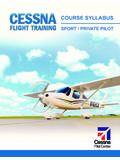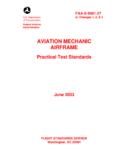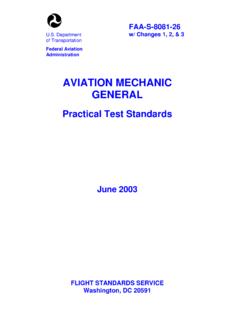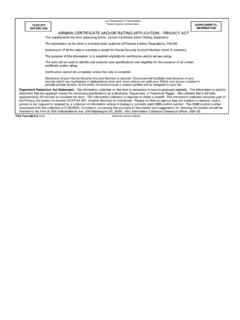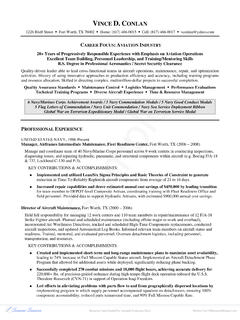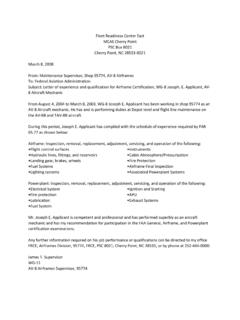Transcription of AVIATION GLOSSARY - Cessna Flight Training
1 AVIATION GLOSSARY 1 100-hour inspection A complete inspection of an aircraft operated for hire required after every 100 hours of operation. It is identical to an annual inspection but may be performed by any certified Airframe and powerplant mechanic. Absolute altitude The vertical distance of an aircraft above the terrain. AD - See Airworthiness Directive. ADC See Air Data Computer. ADF - See Automatic Direction Finder. Adverse yaw - A Flight condition in which the nose of an aircraft tends to turn away from the intended direction of turn. Aeronautical Information Manual (AIM) A primary FAA publication whose purpose is to instruct airmen about operating in the National Airspace System of the A/FD See Airport/Facility Directory. AHRS See Attitude Heading Reference System.
2 Ailerons A primary Flight control surface mounted on the trailing edge of an airplane wing, near the tip. AIM See Aeronautical Information Manual. Air data computer (ADC) The system that receives and processes pitot pressure, static pressure, and temperature to present precise information in the cockpit such as altitude, indicated airspeed, true airspeed, vertical speed, wind direction and velocity, and air temperature. Airfoil Any surface designed to obtain a useful reaction, or lift, from air passing over it. Airmen s Meteorological Information (AIRMET) - Issued to advise pilots of significant weather, but describes conditions with lower intensities than SIGMETs. AIRMET See Airmen s Meteorological Information. Airport/Facility Directory (A/FD) An FAA publication containing information on all airports, seaplane bases and heliports open to the public as well as communications data, navigational facilities and some procedures and special Airspeed indicator A differential pressure gauge that is calibrated to convert the difference between impact air pressure due to an aircraft s motion and the local static air pressure into a reading of velocity through the air mass.
3 Airworthiness certificate A certificate issued by the Federal AVIATION Administration attesting that the aircraft named on the certificate met all required design and performance criteria in force at the time of its manufacture. Airworthiness Directive (AD) A regulatory notice sent out by the Federal AVIATION Administration to the registered owner of an aircraft informing him of the discovery of a condition that keeps his aircraft from continuing to meet its conditions for airworthiness. AVIATION GLOSSARY 2 Alternate static source a source of ambient air pressure from the unpressurized area within an aircraft for use when the static vent malfunctions. It is a less accurate but usable source of the actual air pressure surrounding the aircraft. Altimeter An aneroid barometer calibrated to indicate an aircraft s altitude based on the air pressure measured at a particular point.
4 Angle of attack The acute angle between the chord line of an airfoil and the direction of the air that strikes the airfoil (relative wind). Annual inspection - A complete inspection of an aircraft required by regulation every 12 calendar months. It must be accomplished by a certificated Airframe and powerplant mechanic who also holds an Inspection Authorization. Approach control The Air Traffic Control entity that controls instrument Flight aircraft and some visual Flight rules aircraft immediately prior to hand off to the Local Controller. Artificial horizon Archaic term for Attitude Indicator . ASOS See Automated Surface Observing System. ATIS See Automatic Terminal Information Service. Attitude Indicator An instrument that displays an aircraft s pitch and bank attitudes by reference to a gyro stabilized bar which remains parallel to the horizon.
5 Attitude Heading Reference System (AHRS) An integrated Flight instrument system composed of three-axis sensors that provide attitude, heading, rate of turn, and slip/skid information. AHRS are designed to replace traditional mechanical gyroscopic Flight instruments and provide much greater reliability and accuracy. Attitude indicator The instrument that shows the airplane s relation to the horizon. It is the foundation for all instrument Flight . Automated Surface Observing System (ASOS) - Intended to become the primary surface weather observing system in the United States. ASOS can perform minute by minute observations and perform the basic observations necessary to generate an AVIATION routine weather report (METAR). Automated Weather Observing System (AWOS) - An earlier system similar in purpose to ASOS.
6 From a user standpoint it differs from ASOS in that some AWOS sites report density altitude, but no AWOS sites are capable of reporting precipitation. Automatic direction finder (ADF) An aircraft radio navigation system that senses and indicates the direction to a ground transmitter. Typically used with Nondirectional Radio Beacons (NDBs). Automatic Terminal Information Service (ATIS) - A taped broadcast giving weather and operational information for a particular airport. Auxiliary fuel pump An electrically powered fuel pump used to supply fuel to the engine for starting, or in case of failure of the engine driven pump. AVGAS An acronym for AVIATION gasoline. Gasoline specifically manufactured for aircraft piston engines. The most common type of AVGAS found in General AVIATION today is 100 octane, low lead (100LL) which can be identified by its blue color.
7 AVIATION GLOSSARY 3 Avionics master switch A switch controlling electrical power to all electronic communication and navigation equipment in an aircraft. AWOS See Automated Weather Observing System. Base leg A Flight path at right angles to the landing runway off its approach end. The base leg normally extends from the downwind leg to the intersection of the extended runway centerline. Best lift over drag ratio The highest value of the ratios of Lift to Drag for a particular airfoil. Commonly expressed as L over D max . Blade angle The angle formed between the face of a propeller blade and its plane of rotation. NOTE: in an airplane with the engine mounted in front of the cockpit, the face of the propeller blade is the surface that can be seen from the cockpit.
8 Calibrated airspeed (CAS) The value of airspeed resulting when Indicated Airspeed is corrected for installation error and instrument error. Camber The amount of curve of an airfoil. Carbon monoxide A colorless, odorless, tasteless gas contained in exhaust fumes. It significantly reduces the ability of the blood stream to carry oxygen and can cause the effects of hypoxia. CAS See Calibrated Airspeed. CDI - See Course Deviation Indicator. Center of gravity (CG) - A theoretical point at which the entire weight of an aircraft may be considered to be concentrated. Center of pressure - The point along the chord where the distributed lift of the entire wing is effectively concentrated. CG See Center of Gravity. Chord line An imaginary line drawn through an airfoil from its leading edge to its trailing edge.
9 Clearance An authorization by air traffic control, for the purpose of preventing collision between known aircraft, for an aircraft to proceed under specified traffic conditions within controlled airspace. Clearance delivery The position within a control tower organization responsible for delivering clearances to aircraft departing on instrument flights or visual Flight rule flights that are required to follow special departure routes. This is for aircraft on the ground and clearances are usually delivered prior to taxi. Depending on traffic volume, this may be done by a controller with a separate, dedicated frequency or Ground Control may perform it. Climb A Flight maneuver that increases the aircraft s altitude. AVIATION GLOSSARY 4 Common Traffic Advisory Frequency (CTAF) A frequency designated for the purpose of carrying out airport advisory practices while operating to or from an airport without an operating control tower.
10 Coordinated Universal Time (UTC) A standard time corresponding to the local time for the zone beginning at the meridian through Greenwich England. It is corrected for seasonal variations in the earth s rotation about the sun. By international agreement it is the common time for all AVIATION operations. Course deviation indicator (CDI) The needle in the face of the VOR indicator that indicates whether or not the aircraft is left or right of the course or radial selected. Critical angle of attack The angle of attack at which the air ceases to flow smoothly over an airfoil Crosswind leg - A Flight path at right angles to the landing runway at its upwind end. CTAF See Common Traffic Advisory Frequency. Dead reckoning (DR) A method of navigation using time, speed, distance and the effect of wind computations that determine the direction and speed of the aircraft.
